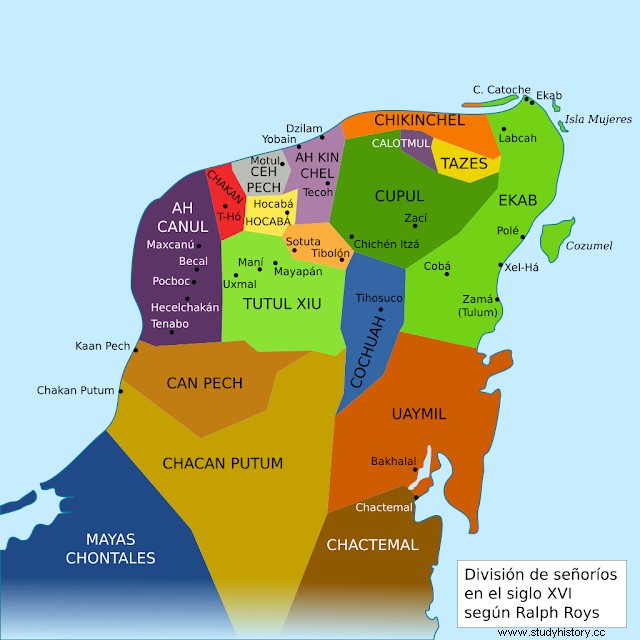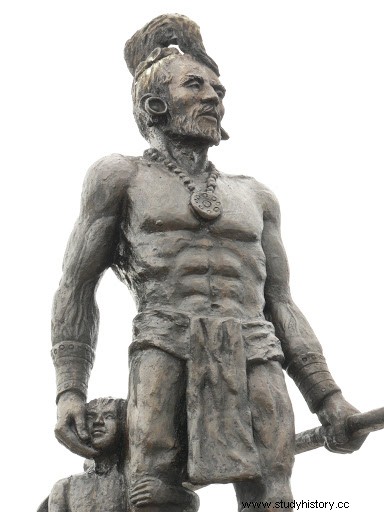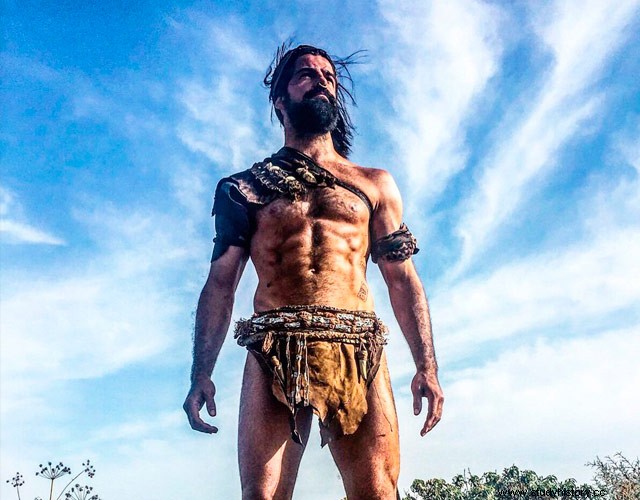"L The Spaniards estimated that Guerrero dedicated himself to training the Mayans to defend his territory "
Gonzalo Guerrero was a Spanish conquistador who was captured and enslaved by the Mayans. Years later, when Hernán Cortés wanted to free him, Gonzalo had already become an Indian warrior.
 Gonzalo Guerrero
Gonzalo GuerreroMovie history is once again what happens to us. Gonzalo Guerrero was born in the year 1470 in Palos de la Frontera (Huelva). Little more is known of his youth. He was more a soldier than a sailor and appears as an arquebusier in the conquest of Granada, in a campaign that culminated on January 2, 1492, when the troops of the Catholic Monarchs, commanded by Gonzalo Fernández de Córdoba, the Great Captain. As an arquebusier he followed the Great Captain to Naples, where Spain began its influence in Europe and its armies formed the units that would later become the famous Spanish Tercios.
Around 1510, Gonzalo Guerrero went with Diego de Nicuesa to America, finding himself immersed in the fratricidal power struggles between the Spaniards. Some time later Gonzalo joins Juan de Valdivia (Nicuesa's enemy) and goes from Darién to Fernandina Island (Santo Domingo) as an officer in charge of slaves and crew of the ship Santa María de Barca, armed in Almería.
They left Darién on August 15, 1511, with good weather. But, at dawn on the third day of sailing, a great storm arose. Hurricane-force winds damaged the ship, while gigantic waves swept across the deck until the ship ran aground. Only eight reach the Yucatan coast, where they entered the lands of the Cocomes, who confronted them. Four of them were executed, while the rest were imprisoned. They arrive at the land of the group of the Tutul Xiúes, enemies of the Cocomes, in the City-State of Maní, to which Xaman Há (currently Playa del Carmen) belonged, where the chief Taxmar hands them over as slaves to Teohom, his priest. , who die of exhaustion, except Gonzalo and Gerónimo. The latter recounted his duties as a slave:"...carrying firewood, water and fish on his back, and Aguilar suffered these tasks with a happy face to ensure life, which is so loved. Naturally he was so subject and obeyed with so much humility, that not only with alacrity did what his master ordered him, but what any Indian no matter how small, so much so that even if he was eating, if they ordered him something, he would stop eating to do the errand."
 Division of Mayan chiefdoms in the 16th century
Division of Mayan chiefdoms in the 16th centuryGeronimo de Aguilar remained faithful to their culture and their religion, while Gonzalo Guerrero was acculturating, sometimes with a lot of sacrifice.
Taxmar would find out about the hard work carried out by his slaves, and that the only two survivors were on the verge of death, he would claim them for himself In that decision, it was taken into account that the two Spaniards had participated in some confrontations with the enemies of the Mayan group, in which they had stood out for their military skills, which is why he considered taking them as war advisers. Gonzalo would teach them different forms of attack and defense, various formations in squares and columns, which included criteria on how not all the combatants had to fight in a closed and disorderly manner, nor at the same time, but taking turns in the lines the same as attacking. on the sides, to alternate combat and rest, in order not to exhaust yourself before the enemies. In addition, he would form a Macedonian phalanx to defeat the Cocomes, with which he achieved great prestige.
Battles of Hispania Official Shop
Taxmar would give Guerrero to the wise chief Na Chan Can, chief of the Cheles in the city of Ichpaatún, north of the Bay of Chetumal, who, in turn, gives it to his Nacom (head of warriors) Balam. Balam treated Guerrero with great care, until one day, when crossing a river, Balam was attacked by an alligator and Gonzalo Guerrero saved the life of his master, who for this fact granted him freedom.
As a warrior and free man of the Mayan group, he participates with great success in several warrior expeditions. He transculturates, letting himself be mutilated and ritual tattoos that were his own at his rank. His victories follow one another and he rises to Nacom by marrying Princess Zazil Há. He allows his own children to have their foreheads flattened with a splint. He too undergoes mutilation rituals, by which warriors demonstrate their contempt for pain and death. His acculturation and integration into the town that had adopted him was so great that it is said that he allowed his eldest daughter, Ixmo, to be sacrificed at Chichen Itza to put an end to a plague of locusts. However, there is no evidence that this happened.
 Sculpture by Gonzalo Guerrero
Sculpture by Gonzalo GuerreroIn 1519, an expedition led by Hernán Cortés landed on the island of Cozumel, who found out that two Spaniards lived on that island and sent messengers to offer to rescue them. Cortés needed interpreters who spoke the languages of the region, therefore, he decided to contact them by sending them letters in which he exhorted them to join his expedition and marked the meeting point:
"Señores y Brothers, here in Cozumél (Cuzamil) I have learned that you are in the power of a detained cacique. I ask you for mercy, that you then come here to Cozumél (Cuzamil), and for this I will send a ship with soldiers, if you need them. and ransom to give to those Indians with whom you are, and the ship has to wait eight days for you. Come with all brevity:you will be well looked after by me, and taken advantage of. I remain here on this island with five hundred soldiers and eleven ships. ."
"The Indians who took the letter from General Hernando Cortés gave it within two days to a Spaniard named Gerónimo de Aguilar, who went to his master with it, and ransoms for him gave permission, which he then gave so that he could go where he pleased. Geronimo Aguilar, given his master's permission, went in search of another of his companions named Gonzalo Guerrero. He showed him the letter, and said what was happening."
"...the Warrior answered:"Brother Aguilar, I am married and have three children. They have me as cacique and captain, when there are wars, my face is carved, and my ears pierced, what will those Spaniards say about me, if they see me go like this? You go with God, you see that these little children of mine are beautiful, and give me for your life those green beads that you bring, to give them, and I will say, that my brothers send them to me from my land. The woman with whom the Warrior was married, who understood Geronimo de Aguilar's talk, angry with him said:Look at what this slave comes to call my husband, and that he left at a bad time, and not take care the rest. Aguilar made another request to the Warrior, so that he would go with him:telling him to remember he was a Christian and not to lose his soul for an Indian woman, that if they did it for his wife and children, he should take them with him, if he felt so much leaving them. He did not take advantage of such a holy admonition, so that Gonzalo Guerrero (who was a sailor, and a native of Palos) went with Gerónimo de Aguilar, who seeing him resolved to stay, went with the two Indians from Cozumél (Cuzamil) to the place, where the ship."
 Geronimo de Aguilar before Cortés
Geronimo de Aguilar before CortésAguilar accepted, while Gonzalo Guerrero preferred to remain with the Mayans. Andrés de Tapia was the first Spaniard who recognized Jerónimo de Aguilar in Cozumel, the shipwrecked man from Nicuesa's fleet who was to serve as an interpreter of the Mayan language.
Gonzalo Guerrero refused to return with several Spanish expeditions, and supported the battles to expel Grijalva, Francisco Hernández de Córdoba (1517) and Cortés (1518). During the following years, the Spanish estimated that Guerrero dedicated himself to training the Mayans to defend their territory, because when Francisco de Montejo, in May 1527, crossed the Atlantic with 380 soldiers in four ships, he encountered serious difficulties in conquering Yucatan. He fights the conquerors Montejo (father and son) and their captain Dávila. He instructs his warriors how to face foreigners, always advising not to give up or trust whites, trying to protect his territory.
 Recreation of Gonzalo Guerrero in the series Ministerio del Tiempo
Recreation of Gonzalo Guerrero in the series Ministerio del TiempoThey say that Montejo sent him a letter in the that he reminded him of his Christian faith and offered him a pardon if he turned himself in, but Guerrero knew that those promises were often broken -in fact, he himself used to warn his own about it- and answered kindly but firmly that he could not leave his wife and his family. children, apart from the fact that he depended on the authority of a cacique, although he claimed to remember God and was open to a good relationship. Diplomacy having failed, it was time for arms and a column under the command of Captain Alonso Dávila entered Yucatecan territory.
In mid-summer he managed to make his way to Chactumal with the double objective of seizing some gold mines ( that turned out to be a myth) and arrest Guerrero. Later he takes some Mayan prisoners. They deceive him by telling him that Gonzalo Guerrero had died naturally, so he sends reports to Montejo about his supposed death.
In reality, he died in 1536 when he was facing the troops of Captain Lorenzo de Godoy to help, with fifty canoes, Cicumba, Tolupan cacique of the town of Ticamaya (Honduras), in the lower valley of the Ulúa River. A crossbow bolt pierced right into his navel and pierced him to the side, where he was mortally wounded by an arquebus shot. His men took him from the battlefield and hid him behind some palm trees. He asked those closest to him to take care of his children and the rest of his men, more than a thousand, to continue fighting. They had to fall back and Guerrero's corpse was left in the enemy camp. It is said that some Spaniards later claimed to have seen him:tattooed and dressed like an Indian, but bearded. During the night, some of his men rescued his body and as a final tribute, they threw it into the Ulúa River, so that the current would carry it to the Ocean from which it came.
Gonzalo Guerrero was for centuries a character hated by the people Spanish, especially for abandoning the Catholic faith. The chroniclers, informed by Jerónimo de Aguilar, present him as a strange and disturbing being. Aguilar, probably a subdeacon, describes in his stories a comparison of his behavior contrary to that of Guerrero. He affirms that he remained chaste and faithful to his king and to his God, instead he argues that Gonzalo Guerrero had succumbed to the temptation of taking a wife, starting a family, mixing his blood with hers. captors of him. That was what, according to Aguilar, lost him, leading him, little by little, to embrace the culture and the gods of his new family.
After the independence of Mexico, many Mexicans began to admire the Mayan culture that they fought their ancestors. Being among them Guerrero a name that symbolized the fight against the colonial and imperialist power.
